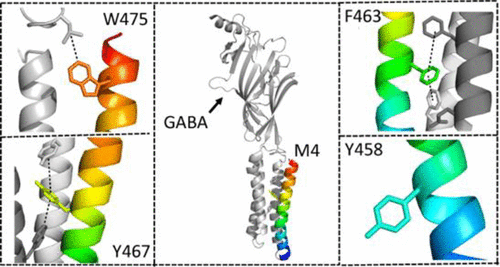当前位置:
X-MOL 学术
›
ACS Chem. Neurosci.
›
论文详情
Our official English website, www.x-mol.net, welcomes your
feedback! (Note: you will need to create a separate account there.)
Aromatic Residues in the Fourth Transmembrane-Spanning Helix M4 Are Important for GABAρ Receptor Function
ACS Chemical Neuroscience ( IF 4.1 ) Pub Date : 2017-11-09 00:00:00 , DOI: 10.1021/acschemneuro.7b00315 James Cory-Wright 1 , Mona Alqazzaz 1 , Francesca Wroe 1 , Jenny Jeffreys 1 , Lu Zhou 1 , Sarah C R Lummis 1
ACS Chemical Neuroscience ( IF 4.1 ) Pub Date : 2017-11-09 00:00:00 , DOI: 10.1021/acschemneuro.7b00315 James Cory-Wright 1 , Mona Alqazzaz 1 , Francesca Wroe 1 , Jenny Jeffreys 1 , Lu Zhou 1 , Sarah C R Lummis 1
Affiliation

|
GABAρ receptors are a subfamily of the GABAA receptor family of pentameric ligand-gated ion channels (pLGICs). Each of the five subunits has four transmembrane α-helices (M1–M4), with M4 most distant from the central pore. Aromatic residues in this M4 helix are important for receptor assembly in pLGICs and also may interact with adjacent lipids and/or residues in neighboring α-helices and the extracellular domain to modify or enable channel gating. This study examines the role of M4 receptor aromatic residues in the GABAρ receptor transmembrane domain using site-directed mutagenesis and subsequent expression in HEK293 cells, probing functional parameters using a fluorescent membrane-potential-sensitive dye. The data indicate that many of the aromatic residues in M4 play a role in receptor function, as substitution with other residues can ablate and/or modify functional parameters. Modeling showed that these residues likely interact with residues in the adjacent M1 and M3 α-helices and/or residues in the Cys-loop in the extracellular domain. We suggest that many of these aromatic interactions contribute to an “aromatic zipper”, which allows interactions between M4 and the rest of the receptor that are essential for function. Thus, the data support other studies showing that M4 does not play a passive role in “protecting” the other transmembrane helices from the lipid bilayer but is actively involved in the function of the protein.
中文翻译:

第四跨膜螺旋 M4 中的芳香族残基对 GABAρ 受体功能很重要
GABAρ 受体是 GABA A的一个亚家族五聚体配体门控离子通道 (pLGIC) 受体家族。五个亚基中的每一个都有四个跨膜α-螺旋(M1-M4),其中 M4 离中心孔最远。该 M4 螺旋中的芳香族残基对于 pLGIC 中的受体组装很重要,并且还可能与相邻的脂质和/或相邻 α-螺旋和细胞外结构域中的残基相互作用,以修饰或启用通道门控。本研究使用定点诱变和随后在 HEK293 细胞中的表达来检查 M4 受体芳香残基在 GABAρ 受体跨膜结构域中的作用,并使用荧光膜电位敏感染料探测功能参数。数据表明,M4 中的许多芳香族残基在受体功能中发挥作用,因为用其他残基取代可以消除和/或改变功能参数。建模显示这些残基可能与相邻 M1 和 M3 α-螺旋中的残基和/或胞外结构域中 Cys 环中的残基相互作用。我们认为,这些芳香族相互作用中的许多都有助于形成“芳香族拉链”,它允许 M4 与其他对功能至关重要的受体之间的相互作用。因此,数据支持其他研究,表明 M4 在“保护”其他跨膜螺旋免受脂质双层影响方面并不发挥被动作用,而是积极参与蛋白质的功能。这允许 M4 与对功能至关重要的其余受体之间的相互作用。因此,数据支持其他研究,表明 M4 在“保护”其他跨膜螺旋免受脂质双层影响方面并不发挥被动作用,而是积极参与蛋白质的功能。这允许 M4 与对功能至关重要的其余受体之间的相互作用。因此,数据支持其他研究,表明 M4 在“保护”其他跨膜螺旋免受脂质双层影响方面并不发挥被动作用,而是积极参与蛋白质的功能。
更新日期:2017-11-09
中文翻译:

第四跨膜螺旋 M4 中的芳香族残基对 GABAρ 受体功能很重要
GABAρ 受体是 GABA A的一个亚家族五聚体配体门控离子通道 (pLGIC) 受体家族。五个亚基中的每一个都有四个跨膜α-螺旋(M1-M4),其中 M4 离中心孔最远。该 M4 螺旋中的芳香族残基对于 pLGIC 中的受体组装很重要,并且还可能与相邻的脂质和/或相邻 α-螺旋和细胞外结构域中的残基相互作用,以修饰或启用通道门控。本研究使用定点诱变和随后在 HEK293 细胞中的表达来检查 M4 受体芳香残基在 GABAρ 受体跨膜结构域中的作用,并使用荧光膜电位敏感染料探测功能参数。数据表明,M4 中的许多芳香族残基在受体功能中发挥作用,因为用其他残基取代可以消除和/或改变功能参数。建模显示这些残基可能与相邻 M1 和 M3 α-螺旋中的残基和/或胞外结构域中 Cys 环中的残基相互作用。我们认为,这些芳香族相互作用中的许多都有助于形成“芳香族拉链”,它允许 M4 与其他对功能至关重要的受体之间的相互作用。因此,数据支持其他研究,表明 M4 在“保护”其他跨膜螺旋免受脂质双层影响方面并不发挥被动作用,而是积极参与蛋白质的功能。这允许 M4 与对功能至关重要的其余受体之间的相互作用。因此,数据支持其他研究,表明 M4 在“保护”其他跨膜螺旋免受脂质双层影响方面并不发挥被动作用,而是积极参与蛋白质的功能。这允许 M4 与对功能至关重要的其余受体之间的相互作用。因此,数据支持其他研究,表明 M4 在“保护”其他跨膜螺旋免受脂质双层影响方面并不发挥被动作用,而是积极参与蛋白质的功能。











































 京公网安备 11010802027423号
京公网安备 11010802027423号